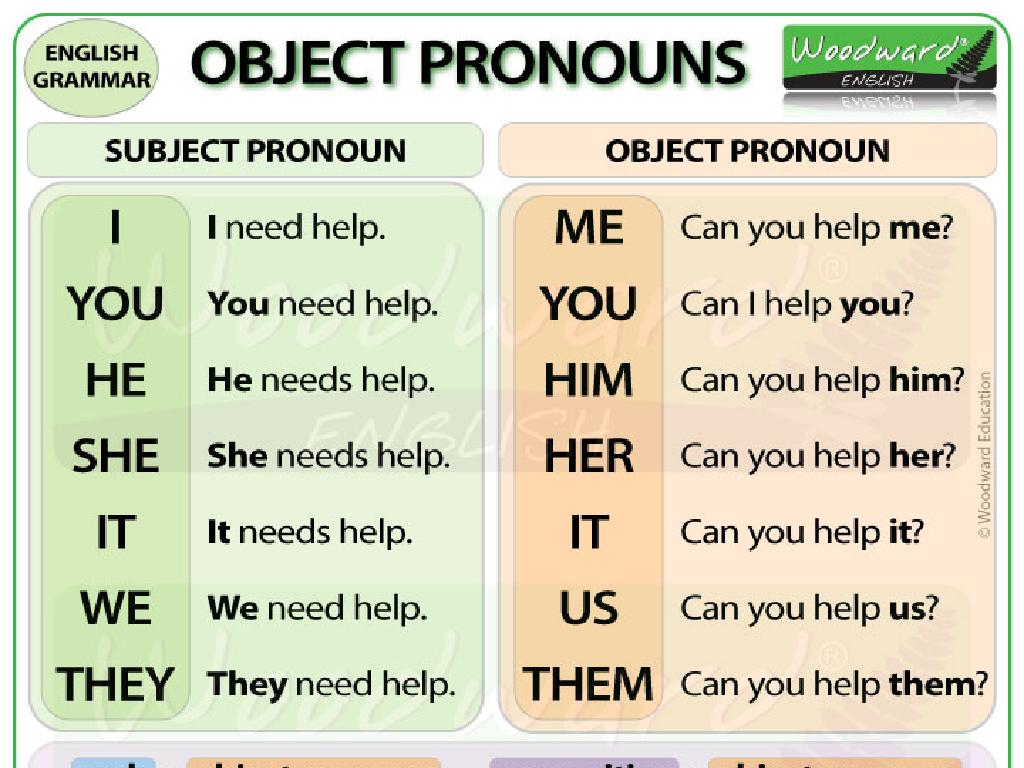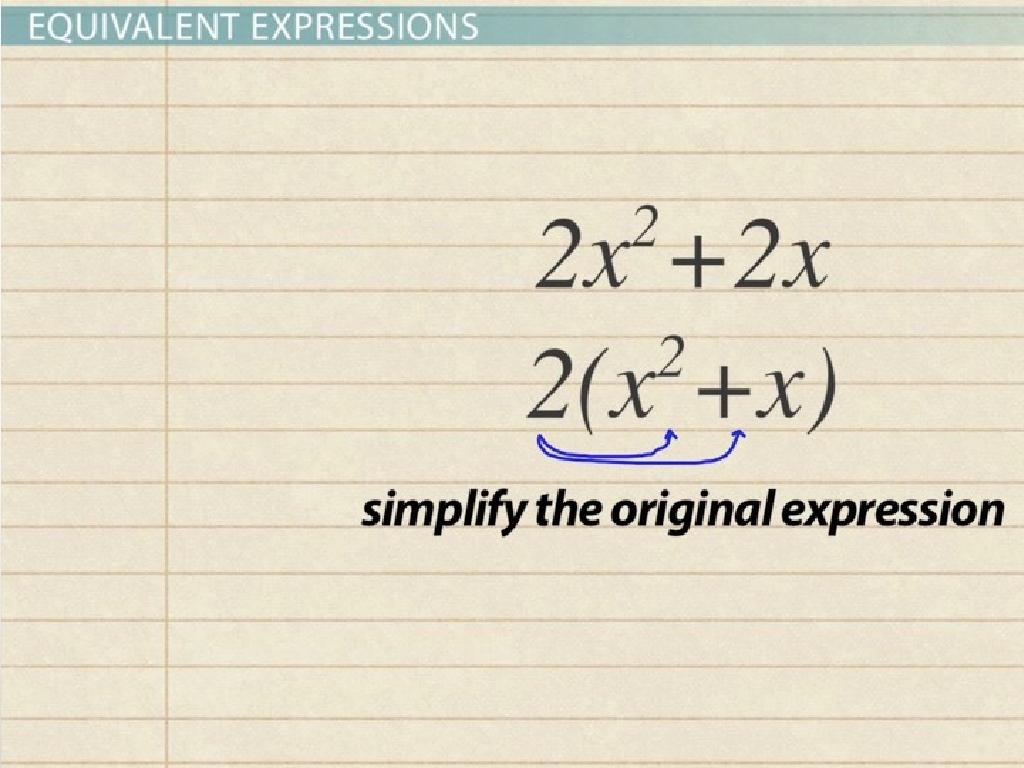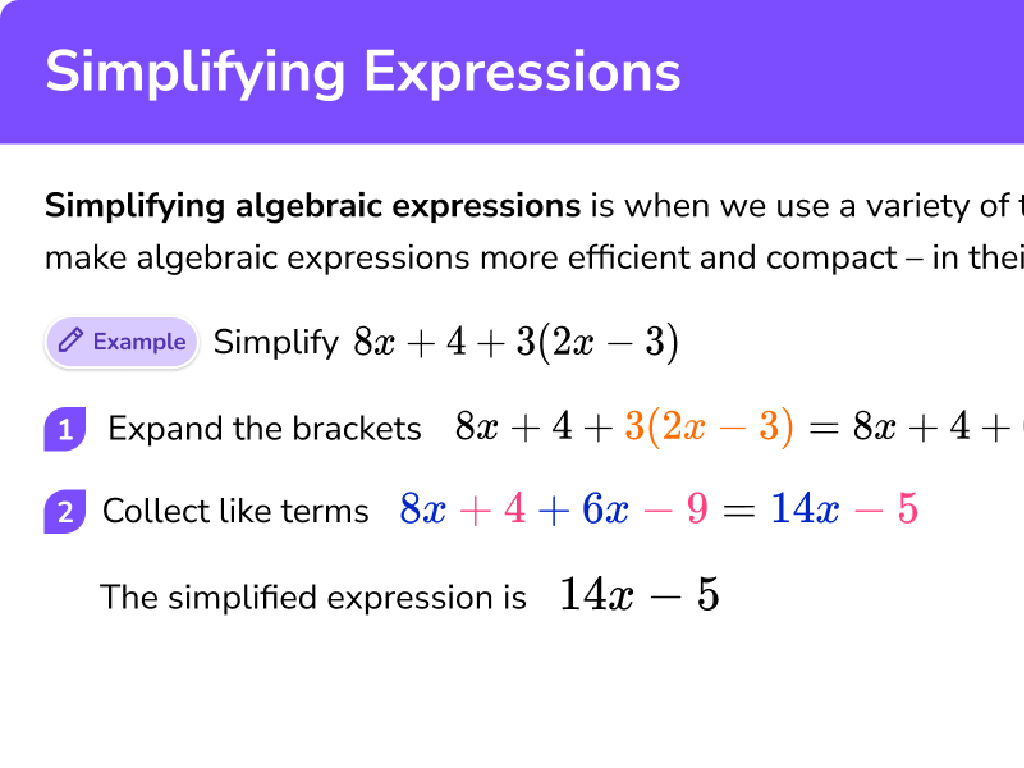Commas With Nonrestrictive Elements
Subject: Language arts
Grade: Eighth grade
Topic: Restrictive And Nonrestrictive Elements
Please LOG IN to download the presentation. Access is available to registered users only.
View More Content
Commas with Nonrestrictive Elements
– Differentiate restrictive vs. nonrestrictive
– Restrictive elements are essential to the meaning of a sentence, while nonrestrictive elements add extra information.
– Nonrestrictive elements & commas
– Nonrestrictive elements are set off by commas, e.g., ‘My brother, who is a doctor, works long hours.’
– The role of punctuation in clarity
– Proper punctuation ensures the reader understands the intended meaning of a sentence.
– Practice identifying nonrestrictive elements
– We’ll look at sentences and decide if elements are nonrestrictive and where commas should go.
|
This slide introduces the concept of nonrestrictive elements and their correct punctuation with commas, which is crucial for writing clarity. Begin by explaining the difference between restrictive and nonrestrictive elements, emphasizing that restrictive elements are integral to the sentence’s meaning, whereas nonrestrictive elements provide additional, but not essential, information. Highlight the importance of using commas to set off nonrestrictive elements, as this can change the meaning conveyed. Provide clear examples to illustrate this point. Engage students with practice sentences where they identify nonrestrictive elements and add commas accordingly. This exercise will help reinforce their understanding and the importance of punctuation in writing.
Understanding Restrictive Elements
– Define Restrictive Elements
– Elements that are crucial to the meaning of a sentence
– Sentences with Restrictive Elements
– ‘The car that is broken is in the garage’ – ‘that is broken’ specifies which car
– Essential nature of Restrictive Elements
– Without them, the sentence’s meaning changes or becomes unclear
– Impact on sentence meaning
|
This slide aims to clarify the concept of restrictive elements in sentences. Restrictive elements are parts of a sentence that are essential to its meaning – if removed, they would alter the message or make it ambiguous. For example, in the sentence ‘The student who won the science fair is giving a speech,’ the clause ‘who won the science fair’ is restrictive because it specifies which student is being referred to. Without this clause, we wouldn’t know which student is giving a speech. Emphasize the importance of these elements and how they differ from nonrestrictive elements, which can be removed without changing the fundamental meaning of the sentence. Encourage students to identify restrictive elements in sentences and understand their role in providing clarity.
Understanding Nonrestrictive Elements
– Define Nonrestrictive Elements
– Nonessential parts of a sentence that can be removed without changing the meaning
– Examples in sentences
– My brother, who is a doctor, lives in Boston.
– Nonrestrictive vs. essential info
– They provide additional details but the sentence still makes sense without them.
– Use of commas with nonrestrictive
– Commas signal a pause and enclose nonrestrictive elements, indicating they’re not crucial to the main point.
|
This slide introduces students to nonrestrictive elements in sentences, which are phrases or clauses that add extra information but are not essential to the core meaning of the sentence. The goal is to help students recognize these elements and understand how to punctuate them correctly with commas. Provide clear examples to illustrate how removing a nonrestrictive element doesn’t change the fundamental meaning of a sentence. Emphasize the use of commas to set these elements apart, reinforcing that they are additional, not integral. Encourage students to create their own sentences with nonrestrictive elements to practice identifying and punctuating them.
The Role of Commas in Nonrestrictive Elements
– Commas affect sentence meaning
– ‘Let’s eat, Grandma!’ vs. ‘Let’s eat Grandma!’
– Commas separate nonrestrictive elements
– Nonrestrictive: ‘My bike, which is red, is new.’ Restrictive: ‘The bike that is red is new.’
– Examples: correct vs. incorrect
– ‘My friend, Sarah, is here.’ vs. ‘My friend Sarah is here.’
– Practice: identify and correct errors
– Students will correct sentences with misplaced commas.
|
This slide emphasizes the importance of comma placement and its impact on the meaning of sentences. Highlight how commas can drastically change the interpretation of a sentence, using the classic example involving Grandma. Explain that nonrestrictive elements, which are not essential to the sentence’s meaning, should be separated by commas. Provide clear examples of correct and incorrect comma usage, particularly in sentences where the meaning changes based on comma placement. Finally, engage students with practice exercises where they identify and correct errors in comma usage, reinforcing their understanding of nonrestrictive elements.
Commas with Nonrestrictive Elements
– Rules for nonrestrictive commas
– Nonrestrictive elements aren’t essential to the sentence’s meaning and are set off by commas.
– Identify nonrestrictive elements
– Find parts of a sentence that add extra info but could be removed without changing the sentence’s meaning.
– Punctuating nonrestrictive elements
– Add commas to separate the nonessential parts of the sentence from the main message.
– Practice with example sentences
– Let’s punctuate: ‘My brother, who is a doctor, works at a hospital’ vs. ‘My brother who is a doctor works at a hospital.’
|
This slide introduces the concept of nonrestrictive elements and how to punctuate them with commas. Begin by explaining the rules: nonrestrictive elements are additional information that can be omitted without altering the meaning of the sentence. Teach students to identify these elements by looking for clauses or phrases that can be removed without changing the sentence’s core message. Practice adding commas to sentences to highlight these nonrestrictive elements. Provide clear examples and encourage students to create their own sentences, both with and without nonrestrictive elements, to understand the difference commas can make.
Let’s Practice: Punctuating Nonrestrictive Elements
– Interactive sentence exercise
– Identify nonrestrictive elements
– Look for extra information that isn’t essential to the sentence’s meaning
– Punctuate with commas correctly
– Add commas to set off the nonessential information
– Discuss comma placement reasons
– Share thoughts on why commas are used to clarify meaning
|
This slide is for an interactive class exercise where students will engage with sentences displayed on the board. The goal is for them to identify nonrestrictive elements parts of a sentence that can be removed without changing the sentence’s fundamental meaning and correctly punctuate them with commas. After the exercise, lead a class discussion to explore the reasons behind their comma placements, reinforcing the concept that nonrestrictive elements should be set off with commas to aid readability and comprehension. For the teacher: Prepare sentences with clear nonrestrictive elements. Possible activities include peer review of comma placement, rewriting sentences without nonrestrictive elements to see the difference, and creating their own sentences with nonrestrictive clauses.
Group Activity: Punctuating Nonrestrictive Elements
– Break into small groups
– Receive a paragraph with missing commas
– Work together to insert commas
– Collaborate to determine where nonrestrictive elements are
– Discuss reasons for comma placement
– Share thoughts on why commas are needed in those spots
|
This group activity is designed to reinforce the concept of nonrestrictive elements and the use of commas. Students will break into small groups, each receiving a paragraph where commas have been omitted. Their task is to work together to identify nonrestrictive elements and correctly insert commas. After completing the task, each group will discuss their comma placements and the reasoning behind them. For the teacher: Prepare paragraphs of varying difficulty, ensure each group has a different paragraph to promote a diverse discussion later. Possible paragraphs could include descriptions of people, lists of items, or complex sentences with multiple clauses. Encourage students to explain their reasoning for each comma placement to the class, fostering a deeper understanding of the rules for nonrestrictive elements.
Review and Reflect: Nonrestrictive Elements
– Recap on nonrestrictive elements
– Nonrestrictive elements add extra info and are set off by commas, like appositives.
– Discuss today’s key takeaways
– Reflect on the importance of commas for clarity in writing.
– Engage in a Q&A session
– Prepare questions about today’s lesson for discussion.
– Clarify any lingering doubts
|
This slide aims to consolidate the students’ understanding of nonrestrictive elements and their punctuation with commas. Begin by reviewing the definition of nonrestrictive elements and how they provide additional, non-essential information within a sentence. Emphasize that these elements should be enclosed in commas to indicate their separability from the rest of the sentence. Encourage students to discuss the key points from today’s lesson, fostering a deeper understanding of the material. The Q&A session is crucial for addressing any uncertainties and ensuring that all students are confident in identifying and punctuating nonrestrictive elements. As a teacher, be prepared to provide examples and further explanations to clear up any confusion.
Homework: Crafting Stories with Nonrestrictive Elements
– Write a short story for homework
– Include 5 nonrestrictive elements
– Nonrestrictive elements add extra info and are not essential to the sentence’s meaning
– Punctuate nonrestrictive elements correctly
– Use commas to set off nonrestrictive clauses from the rest of the sentence
– Share your story in our next class
|
This homework assignment is designed to reinforce the concept of nonrestrictive elements and their correct punctuation with commas. Students are expected to write a short story that includes at least five nonrestrictive elements, which are phrases or clauses that can be removed without changing the fundamental meaning of the sentence. They must use commas to correctly punctuate these elements. In the next class, students will have the opportunity to share their stories, allowing them to demonstrate their understanding and to learn from each other’s use of language. As a teacher, be prepared to provide examples of nonrestrictive elements and guide students on how to use commas to set them apart in a sentence.
Class Closure: Mastering Commas with Nonrestrictive Elements
– Recap today’s comma rules
– Review the key points on nonrestrictive elements and their punctuation.
– Homework: Practice sentences
– Complete the worksheet on nonrestrictive elements, due next class.
– Use commas confidently
– Encourage applying today’s lesson in your daily writing.
– Questions and clarifications
|
As we wrap up today’s lesson on commas with nonrestrictive elements, it’s important to revisit the main points to reinforce learning. Remind students of the homework assignment, which involves completing a worksheet designed to practice the correct use of commas in sentences with nonrestrictive elements. Encourage students to apply these rules in their everyday writing, emphasizing that proper punctuation can greatly enhance the clarity of their work. Open the floor for any questions or clarifications to ensure students leave the class with a solid understanding of the material covered.






